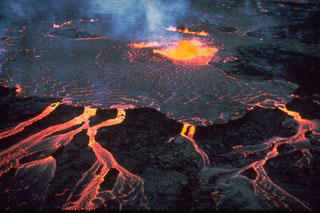Report on Kilauea (United States) — 20 January-26 January 2021
Smithsonian Institution / US Geological Survey
Weekly Volcanic Activity Report, 20 January-26 January 2021
Managing Editor: Sally Sennert.
Please cite this report as:
Global Volcanism Program, 2021. Report on Kilauea (United States) (Sennert, S, ed.). Weekly Volcanic Activity Report, 20 January-26 January 2021. Smithsonian Institution and US Geological Survey.
Kilauea
United States
19.421°N, 155.287°W; summit elev. 1222 m
All times are local (unless otherwise noted)
HVO reported that low lava fountains from a vent on a cone on the inner NW wall of Kilauea’s Halema`uma`u Crater fed flows that traveled down a channel into a perched lava lake during 20-26 January. The western half of the lake deepened from 202 to 205 m and was perched ~4 m above the solidified lava crust adjacent to the crater wall. The stagnant E half remained slightly lower, perched ~2 m above the adjacent crust. The islands remained stationary in the E part of the lake; the dimensions of the largest island remained unchanged and was 23 m above the lake’s surface at the highest point. The sulfur dioxide emission rate was 2,200 tons/day on 23 January.
Geological Summary. Kilauea overlaps the E flank of the massive Mauna Loa shield volcano in the island of Hawaii. Eruptions are prominent in Polynesian legends; written documentation since 1820 records frequent summit and flank lava flow eruptions interspersed with periods of long-term lava lake activity at Halemaumau crater in the summit caldera until 1924. The 3 x 5 km caldera was formed in several stages about 1,500 years ago and during the 18th century; eruptions have also originated from the lengthy East and Southwest rift zones, which extend to the ocean in both directions. About 90% of the surface of the basaltic shield volcano is formed of lava flows less than about 1,100 years old; 70% of the surface is younger than 600 years. The long-term eruption from the East rift zone between 1983 and 2018 produced lava flows covering more than 100 km2, destroyed hundreds of houses, and added new coastline.
Source: US Geological Survey Hawaiian Volcano Observatory (HVO)

